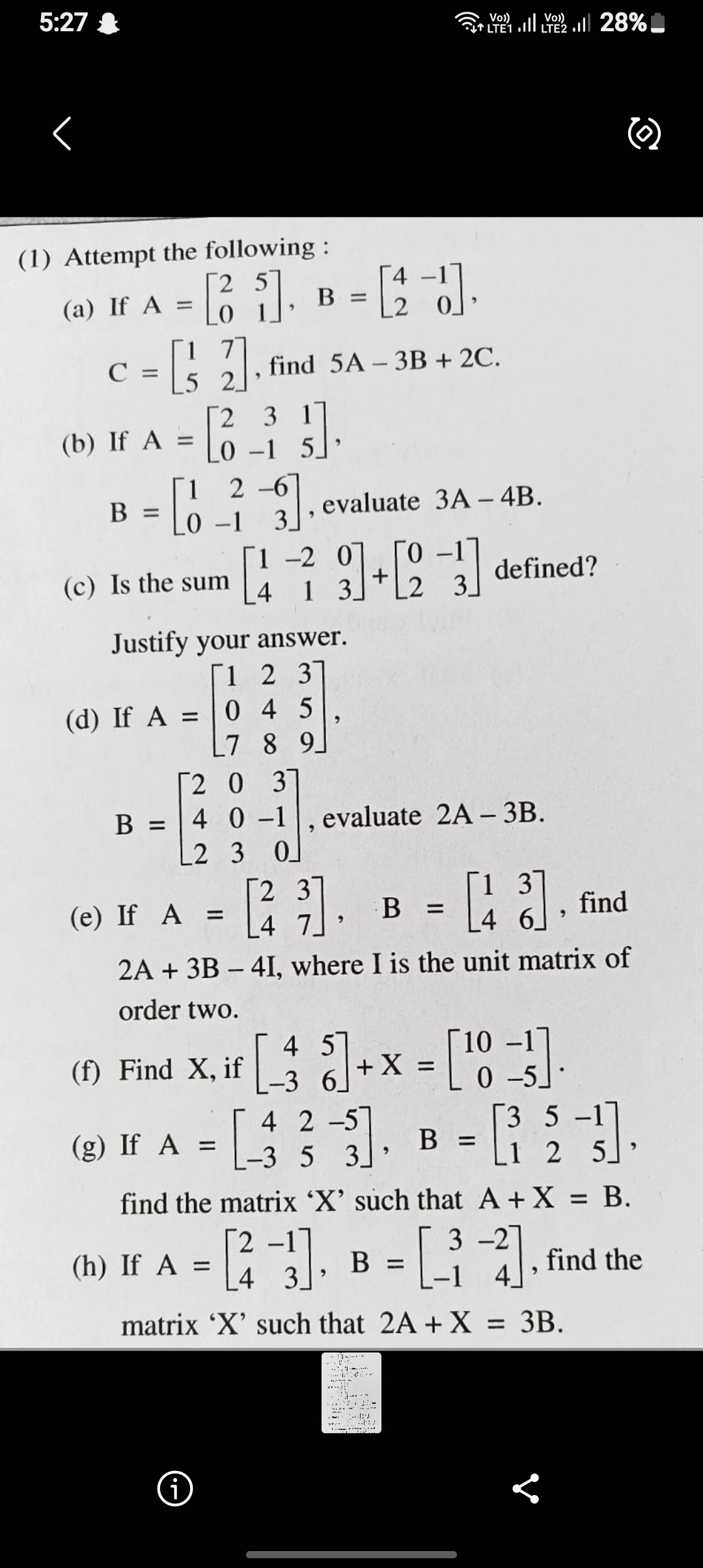1. Attempt the following: (a) If A = [2 5; 0 1], B = [4 -1; 2 0], C = [1 7; 5 2], find 5A - 3B + 2C. (b) If A = [2 3 1; 0 -1 5], B = [1 2 -6; 0 -1 3], evaluate 3A - 4B. (c) Is the... 1. Attempt the following: (a) If A = [2 5; 0 1], B = [4 -1; 2 0], C = [1 7; 5 2], find 5A - 3B + 2C. (b) If A = [2 3 1; 0 -1 5], B = [1 2 -6; 0 -1 3], evaluate 3A - 4B. (c) Is the sum [1 -2 0; 4 1 3] + [0 -1 3] defined? Justify your answer. (d) If A = [1 2 3; 0 4 5; 7 8 9], B = [2 0 3; 4 0 -1; 2 3 0], evaluate 2A - 3B. (e) If A = [2 3; 4 7], B = [1 3; 4 6], find 2A + 3B - 4I, where I is the unit matrix of order two. (f) Find X, if [4 5; -3 6] + X = [10 -1; 0 -5]. (g) If A = [4 2 -5; -3 5 3], B = [3 5 -1; 1 2 5], find the matrix X such that A + X = B. (h) If A = [2 -1; 4 3], B = [-1 2; 4], find the matrix X such that 2A + X = 3B.

Understand the Problem
The question comprises a series of problems related to matrix operations, including matrix addition, subtraction, evaluation of defined expressions, and the finding of specific matrices based on given conditions. Each part requires knowledge of matrix arithmetic and properties.
Answer
$$ \begin{pmatrix} 0 & 42 \\ 4 & 9 \end{pmatrix} $$
Answer for screen readers
The result of (5A - 3B + 2C) is: $$ \begin{pmatrix} 0 & 42 \ 4 & 9 \end{pmatrix} $$
Steps to Solve
-
Calculate (5A)
Multiply matrix (A) by 5.
Given (A = \begin{pmatrix} 2 & 5 \ 0 & 1 \end{pmatrix}),
[ 5A = 5 \cdot \begin{pmatrix} 2 & 5 \ 0 & 1 \end{pmatrix} = \begin{pmatrix} 10 & 25 \ 0 & 5 \end{pmatrix} ] -
Calculate (3B)
Multiply matrix (B) by 3.
Given (B = \begin{pmatrix} 4 & -1 \ 2 & 0 \end{pmatrix}),
[ 3B = 3 \cdot \begin{pmatrix} 4 & -1 \ 2 & 0 \end{pmatrix} = \begin{pmatrix} 12 & -3 \ 6 & 0 \end{pmatrix} ] -
Calculate (2C)
Multiply matrix (C) by 2.
Given (C = \begin{pmatrix} 1 & 7 \ 5 & 2 \end{pmatrix}),
[ 2C = 2 \cdot \begin{pmatrix} 1 & 7 \ 5 & 2 \end{pmatrix} = \begin{pmatrix} 2 & 14 \ 10 & 4 \end{pmatrix} ] -
Combine results: (5A - 3B + 2C)
Perform the operation (5A - 3B + 2C).
First, calculate (5A - 3B):
[ 5A - 3B = \begin{pmatrix} 10 & 25 \ 0 & 5 \end{pmatrix} - \begin{pmatrix} 12 & -3 \ 6 & 0 \end{pmatrix} = \begin{pmatrix} 10 - 12 & 25 - (-3) \ 0 - 6 & 5 - 0 \end{pmatrix} = \begin{pmatrix} -2 & 28 \ -6 & 5 \end{pmatrix} ] Now add (2C):
[ (-2, 28 \ -6, 5) + (2, 14 \ 10, 4) = \begin{pmatrix} -2 + 2 & 28 + 14 \ -6 + 10 & 5 + 4 \end{pmatrix} = \begin{pmatrix} 0 & 42 \ 4 & 9 \end{pmatrix} ]
The result of (5A - 3B + 2C) is: $$ \begin{pmatrix} 0 & 42 \ 4 & 9 \end{pmatrix} $$
More Information
This solution demonstrates the process of matrix addition and subtraction through scalar multiplication, which is useful for understanding linear transformations and operations in linear algebra.
Tips
- Failing to align matrices when performing addition or subtraction can lead to errors.
- Forgetting to distribute the scalar multiplication correctly before combining matrices.
AI-generated content may contain errors. Please verify critical information